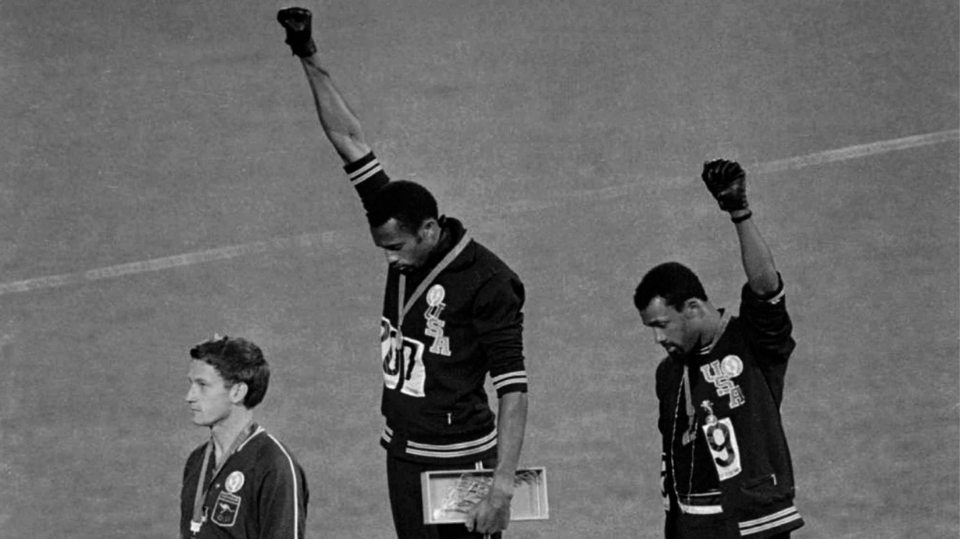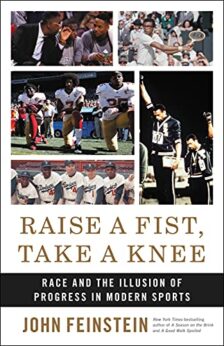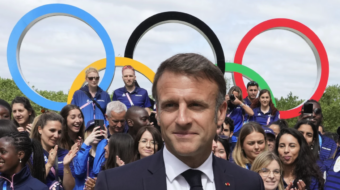
It instantly became iconic. Two young Black men stood ramrod straight with heads bowed and arms raised with clenched, black-gloved fists. Tommie Smith and John Carlos, with Olympic medals draped across their necks, stood stoically on the first-and third-place podiums. They were shoeless while wearing black socks that represented the poverty faced by most African Americans. The white Australian Peter Norman, who finished second in the 200-meter race, stood between them.
It was 1968. I didn’t need the picture on the front cover of John Feinstein’s Raise a Fist, Take a Knee: Race and the Illusion of Progress in Modern Sports. I saw it on TV as did millions across the globe who were watching the Summer Olympic games from Mexico City that year. As with many others, it became etched in my neural pathways.
What looked spontaneous was actually the opposite. An abundance of organizing and riveting history was behind all these happenings. It would impact all three athletes for the rest of their lives and inspire millions.
Many thought it was the murder of Dr. Martin Luther King that April that was behind the protest. While it lent militancy to the action, its impetus stretched back to the 1930s with anti-fascist underpinnings.
The organization Olympic Project for Human Rights (OPHR), that Smith and Carlos joined, had considered boycotting the 1968 Olympics. They had three demands:
- Rhodesia and South Africa must be barred from the games due to their apartheid policies;
- Muhammad Ali must be restored as heavyweight champion (his title had been stripped from him for declining to be drafted during the U.S. War in Vietnam); and
- Avery Brundage must be removed as chairman of the International Olympic Committee (IOC).
Demand number one happened, but the others did not. Brundage was targeted by rank and file Olympians for two reasons. He had appeased the Nazis during the 1936 Olympics by preventing Jesse Owens’s introduction to Hitler. The fascist leader did not want to shake hands with a Black man. Further, Brundage removed two Jewish athletes from an American relay team for similar reasons.
As they were waiting to take their places on the podiums, Norman noticed the OPHR buttons worn by Smith and Carlos. To show solidarity with them, he also wanted to wear one of the buttons. Norman raced into the audience and borrowed one from another American athlete. All three took to the podiums for the solemn raising of their country’s flags wearing the rank and file group’s button.
Smith and Carlos were immediately banned from the Olympic movement. Brundage ordered that they immediately leave the Olympic village and fly home. They were ordered, by Brundage again, to turn in their medals. They never did.
There was even an attempt to sanction the American athlete who gave Norman the OPHR pin!
The backlash by an obedient media was instant. Brent Musburger, writing for his employers at the Chicago American, labeled Smith and Carlos, “black-skinned stormtroopers.” How’s that for turning history on its head! Musburger quickly moved up in print and TV sports media.
What about the act of solidarity by the Australian? It would also drastically alter his life. It is important to note that Peter Norman came to all this with a background in civil rights battles in Australia. He had fought against a nonwhite exclusionary policy for immigrants in his home country. Movements impact lives and influence future decisions—courageous ones.
 Norman was left off the 1972 Australian Olympic team. In 2000, with the games now in Australia, the Olympic host committee did not invite Norman, in spite of the fact that he was an Olympian silver medalist and still held the national record in the 200-meter sprint. He was told that he could buy a ticket.
Norman was left off the 1972 Australian Olympic team. In 2000, with the games now in Australia, the Olympic host committee did not invite Norman, in spite of the fact that he was an Olympian silver medalist and still held the national record in the 200-meter sprint. He was told that he could buy a ticket.
The three athletes remained fast friends. San José State University decided to honor Smith and Carlos with a statue in the new millennium. It depicts them on the first- and third-place finisher’s platforms. Norman was there for the unveiling in 2005. He had insisted that the second-place platform be left empty so visitors could “join” the protest by standing with the Black athletes.
There is much more in the Feinstein book. The ramifications of quarterback Colin Kaepernick taking a knee during the playing of the national anthem at professional football games are detailed. The trials of Black coaches in multiple sports are there.
What’s missing from the Feinstein book is long-term solutions. One example would be reparations for African Americans due to their centuries of enslavement and of building wealth here. However, the Smith and Carlos stories, the anti-fascism, and the solidarity shown by Norman, are worth the read alone.
Tommie Smith and John Carlos had profound respect for Peter Norman. When he died in 2006, they both flew to Australia to deliver the eulogy. They were on either side of the casket as pallbearers. These many lessons of anti-fascist and social justice solidarity, spanning some 90 years, need to be retold widely.
John Feinstein
Raise a Fist, Take a Knee: Race and the Illusion of Progress in Modern Sports
Little, Brown and Co., 2021
366 pp.
ISBN-13: 9780316540933












Comments